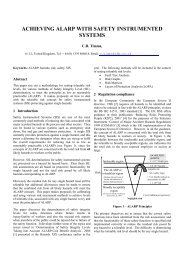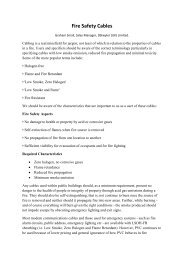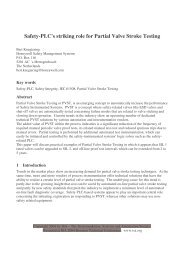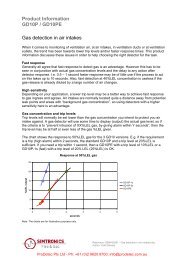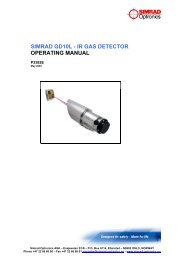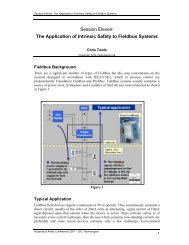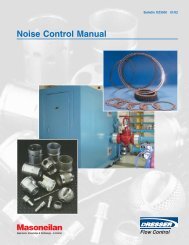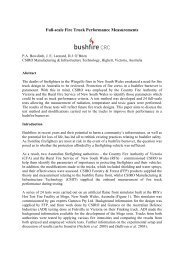Balanced bellows pressure relief valves - ICEWeb
Balanced bellows pressure relief valves - ICEWeb
Balanced bellows pressure relief valves - ICEWeb
You also want an ePaper? Increase the reach of your titles
YUMPU automatically turns print PDFs into web optimized ePapers that Google loves.
valve (with intact <strong>bellows</strong>) to vent locally to atmosphere on a demand for the <strong>pressure</strong><strong>relief</strong> valve to open. This action does not impair the normal operation of the balanced<strong>bellows</strong> <strong>pressure</strong> <strong>relief</strong> valve and does not result in a local vent of toxic or flammablehydrocarbons. However, in the event of failure of the <strong>bellows</strong> the shuttle is displaced soas to block the bonnet vent. Blockage of the vent will then impair the performance of the<strong>pressure</strong> <strong>relief</strong> valve as described for the plug above, although significantly reducing theamount of toxic or flammable gas released local to the valve. The main advantage of thetelltale over the plug is that monitoring of the telltale post-<strong>pressure</strong> <strong>relief</strong> will indicate<strong>bellows</strong> failure.5. Adopting the above measures while tackling local toxic and flammable hydrocarbonreleases diverts attention away from, and obscures the underlying causes of, thepotentially more significant failure of the <strong>bellows</strong>. When the <strong>pressure</strong> <strong>relief</strong> valve (withthe failed <strong>bellows</strong>) is required to open, potentially critical over<strong>pressure</strong> may occur. This isdue to the <strong>pressure</strong> <strong>relief</strong> valve starting to open at a <strong>pressure</strong> above the required set<strong>pressure</strong>, and also to limitations in flow capacity arising from a decrease in lift of thevalve disc from the valve seat. The force applied to the valve disc by the back <strong>pressure</strong>from the vent or flare system transmitted via the burst <strong>bellows</strong> can cause either of theabove symptoms.Action required6. The following actions must be taken:(a) ImmediateInstallation operators must survey all balanced <strong>bellows</strong> <strong>pressure</strong> <strong>relief</strong> <strong>valves</strong> in serviceon their installations to ascertain the mode of bonnet venting. Where plugs or telltales arein place, the consequences of the blocked bonnet vent on <strong>relief</strong> valve performance mustbe established. Where vessel code over-protection requirements are not met due to ablocked bonnet vent affecting the balanced <strong>bellows</strong> <strong>pressure</strong> <strong>relief</strong> valve, the plug ortelltale must be removed. This must be done safely. Plug or telltale removal mayintroduce the risk of local venting of flammable or toxic gas. Where risk assessmentshows immediate removal of the plug or telltale to be unsafe, the affected system must betaken out of service immediately, unless adequate alternative over-<strong>pressure</strong> protection isavailable.(b) Longer termWhere failure of <strong>bellows</strong> has resulted in the application of plugs or telltales to bonnetvents, the following aspects must be reviewed and remedial measures implemented:i. The root cause of <strong>bellows</strong> failure should be investigated with the <strong>bellows</strong> andvalve manufacturer (chattering, incorrect material specification, incorrect<strong>pressure</strong> rating, incorrect installation, incorrectly specified fatigue life, incorrectdimensional tolerances on <strong>bellows</strong> manufacture etc) to eliminate <strong>bellows</strong> failureso far as is reasonably practicable.ii. If local release of toxic or flammable hydrocarbons cannot be tolerated thenbonnet vents should be piped to a safe location as recommended by API RP 520.iii. If <strong>bellows</strong> failure cannot be eliminated (in circumstances when valveperformance is impaired) then different <strong>pressure</strong> <strong>relief</strong> valve types should beprovided.Relevant legal requirements




